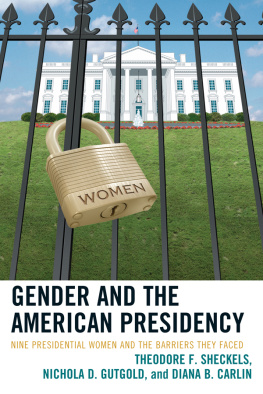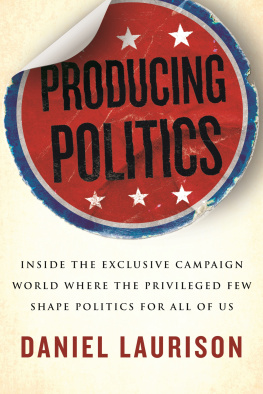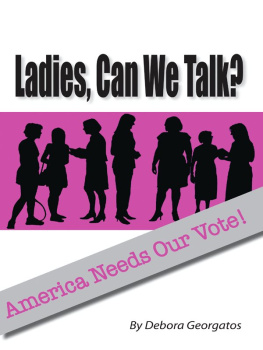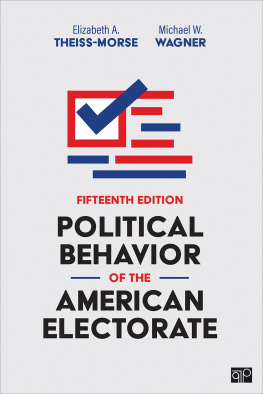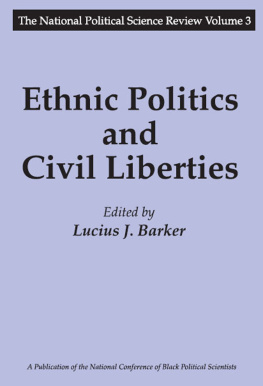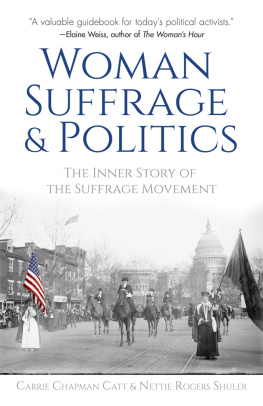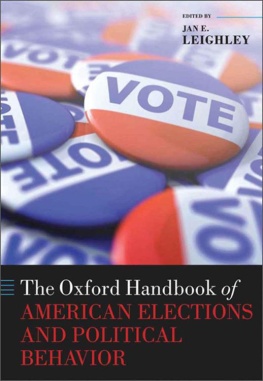RUNNING AS A WOMAN
RUNNING AS A WOMAN
Gender and Power in American Politics

LINDA WITT
KAREN M. PAGET
GLENNA MATTHEWS

THE FREE PRESS
New York London Toronto Sydney Tokyo Singapore
Atheneum Books for Young Readers
An imprint of Simon & Schuster Childrens Publishing Division
1230 Avenue of the Americas, New York, New York 10020
www.SimonandSchuster.com
This book is a work of fiction. Any references to historical events, real people, or real locales are used fictitiously. Other names, characters, places, and incidents are products of the authors imagination, and any resemblance to actual events or locales or persons, living or dead, is entirely coincidental.
Copyright 1994, 1995 by Linda Witt, Karen M. Paget, and Glenna Mathews
All rights reserved. No part of this book may be reproduced or transmitted in any form or by any means, electronic or mechanical, including photocopying, recording, or by any information storage and retrieval system, without permission in writing from the Publisher.
The Free Press
A Division of Simon & Schuster Inc.
866 Third Avenue, New York, N.Y. 10022
First Free Press Paperback Edition 1995
Printed in the United States of America
printing number
1 2 3 4 5 6 7 8 9 10
Library of Congress Cataloging-in-Publication Data
Witt, Linda
Running as a woman : gender and power in American politics / Linda
Witt, Karen M. Paget, Glenna Matthews.
p. cm.
Includes bibliographical references and index.
ISBN 0-02-874069-6
eISBN-13: 978-1-4391-0610-5
ISBN-13: 978-0-0287-4069-0
1. Women in politicsUnited States.
I. Paget, Karen M.
II. Matthews, Glenna.
III. Title.
HQ1391.U5W58 1994
320.082dc20 93-14615
CIP
To Jim
LW
To Janet, Ruth, Pen, and Tim
who made being a woman in politics so incredible
KP
To my aunt, Norma Nicolais Cook,
an important source of love and continuity in my life
To the memory of my uncle,
Wilbur Nicolais
GM
CONTENTS

PREFACE:
THE BIRTHING OF A BOOK
This book was conceived as a result of something women do wella friend got friends togetherand it has been blessed with many midwives. The first, Josie Heath, late in 1989 introduced two old friends of hers, journalist Linda Witt and political scientist Karen Paget. The book gestated over several long lunches spent discussing the various women running for high-stakes political office in 1990among them their mutual friend Josie Heath, who was running for the U.S. Senate from Colorado.
Change was in the air that year. The Berlin Wall had tumbled. A new phrase, peace dividend, was all the buzz among the media and politicians. Pundits were predicting this newfound windfall would focus the publics interest on domestic issues, thus flinging open the doors of governors mansions and the U.S. Congress to the type of candidates deemed most tied to those issues: women. The year 1990 would be, they said, The Year of the Woman in Politics.
To the two of us enjoying those getting-to-know-you lunches, the hype seemed too reminiscent of earlier electoral cycles, of earlier raised and dashed hopes: 1984 and Geraldine Ferraro, 1972 and a big freshman class that did include Congresswoman Patricia Schroeder, Yvonne Brathwaite Burke, and Barbara Jordan but still failed to create a critical mass.
But we were sensing something new in 1990. Not numbers, but a new level of confidence among women candidates. A new sense of legitimacy and entitlement. Gone was the old defensive posture, It doesnt matter that Im a woman. I can do this job as well as any man. Suddenly it did matter. Women candidates were arguing they would bring different views to the process of making public policy. There was a new edge in their voices and campaign messages. And there were new kinds of women entering the arena: women whose life experiences in the varied neighborhoods of America meant new ways of seeing political issues, new ways of expressing the policy needs of women and families, and a new sense that our national government might finally even look like all our people.
Enter the third member of this team, historian Glenna Matthews, whose earlier book, Just a HousewifeThe Rise and Fall of Domesticity in America, had given both the journalist and the political scientist new insights into the ways American womens cultural traditions meshed with politics. One of us said to the other, You should meet and we discovered we both already were friends with Glenna. At the next lunch, as Linda and Karen began listing for Glenna the messages we were hearing in womens campaign slogans, she began explaining how they echoed the rationales American women had used, long before suffrage, to have a political voice.
When yet another friend, Lael Stegall, hosted a book birthing dinner party for us in Washington, D.C., early in 1991, we feasted as much on the richness and depth of some three dozen politically involved womens experiences and knowledge as on the food. It was a diverse group: some former candidates, some former campaign staffers, some just politically aware citizens. Among the midwives were author Celia Morris, the McCormick Foundations Ruth Adams, Brigadier General Wilma Vaught (USAF-Ret.) and EMILYs List founder Ellen Malcolm.
When we began Running as a Woman, we had simple goals. The political scientist and the historian have taught various gender- and politics-related courses at the University of California at Berkeley and Stanford University, as well as elsewhere, and both felt a need for a contemporary text that would explain why women finally are beginning to succeed electorallyand what held them back for so long. As a reporter and columnist who has covered national politics since 1968 and whose special interest has been womens issues, the journalist wanted to tell the stories of the remarkable women who pioneered politics and made possible the swelling pipeline of elected women officials all across the country. What we did not understand then was how hard it would be to construct the necessary bridges to each others disciplinary knowledge, ways of thinking, and ways of working. We accomplished it because we began as friends, and friends of friends, all philosophically committed to womens equality.
The wealth of professional experience and insight each of us brought from our respective disciplines led us much further than we had imagined possible, and we came to understand that the book we wanted to write could not be written by any two of us without the third. Despite our involvement in our generations politics and more than a quarter century each as participant/beneficiary/observers of the womens movement, our knowledge overlapped only occasionally. There were times, at our weekly brainstorming sessions, when one of us would struggle to find words that might explain some new direction her own investigation had taken, only to discover that one of the others could give it a name or connect it to another scholars thinking or at least fit another piece into the puzzle.
Next page

